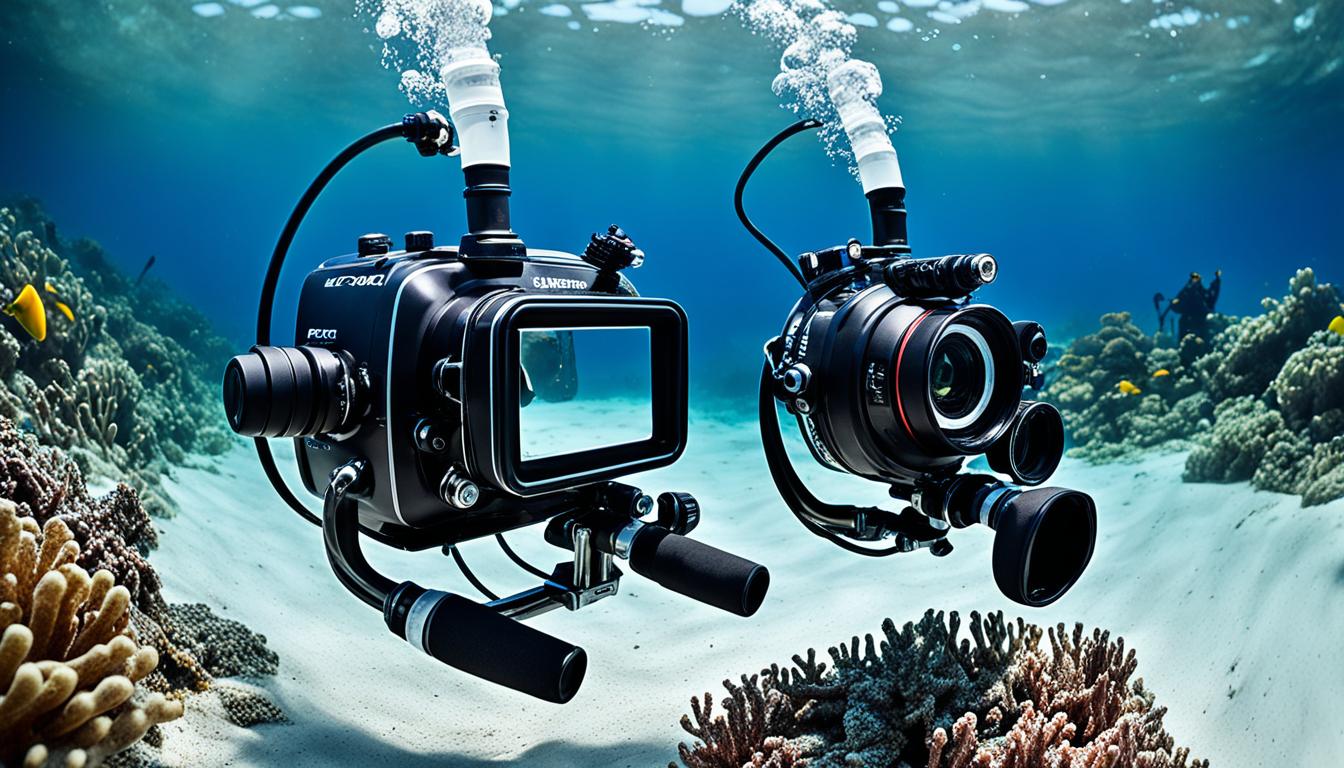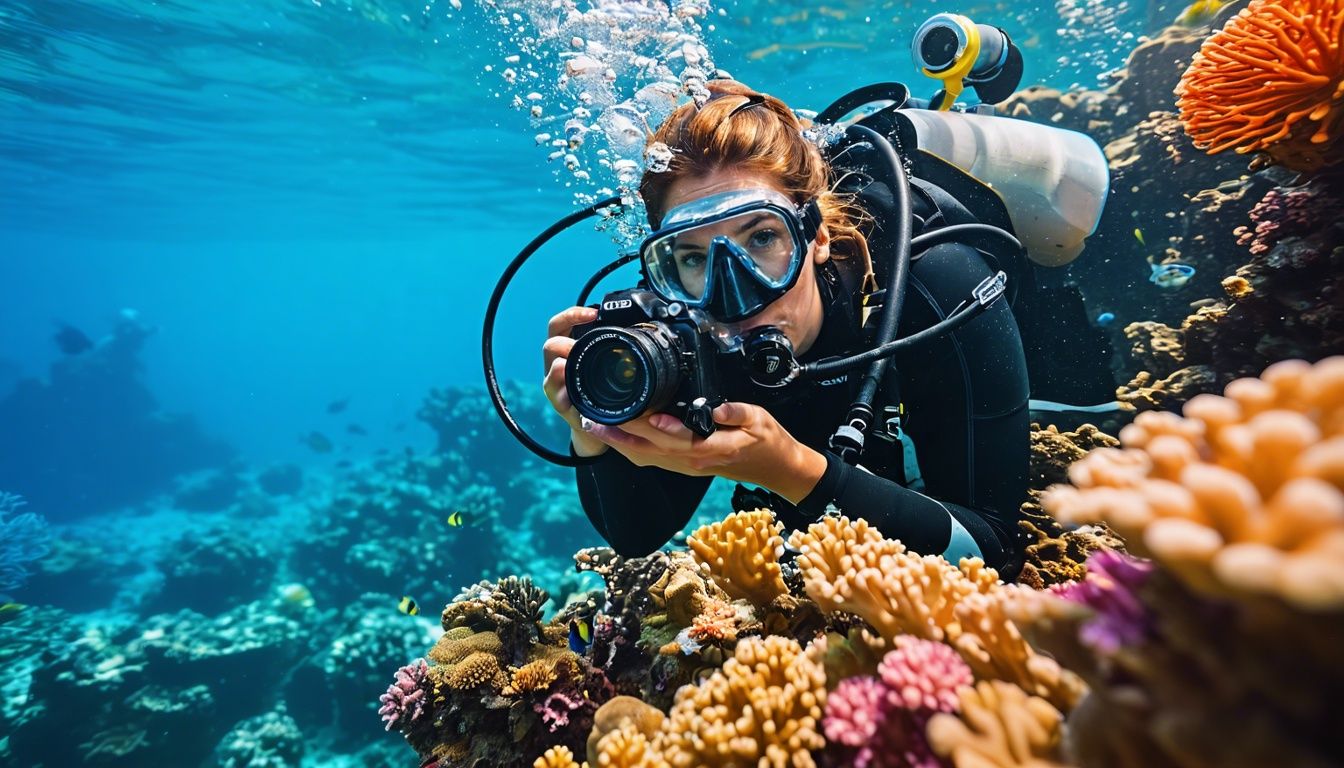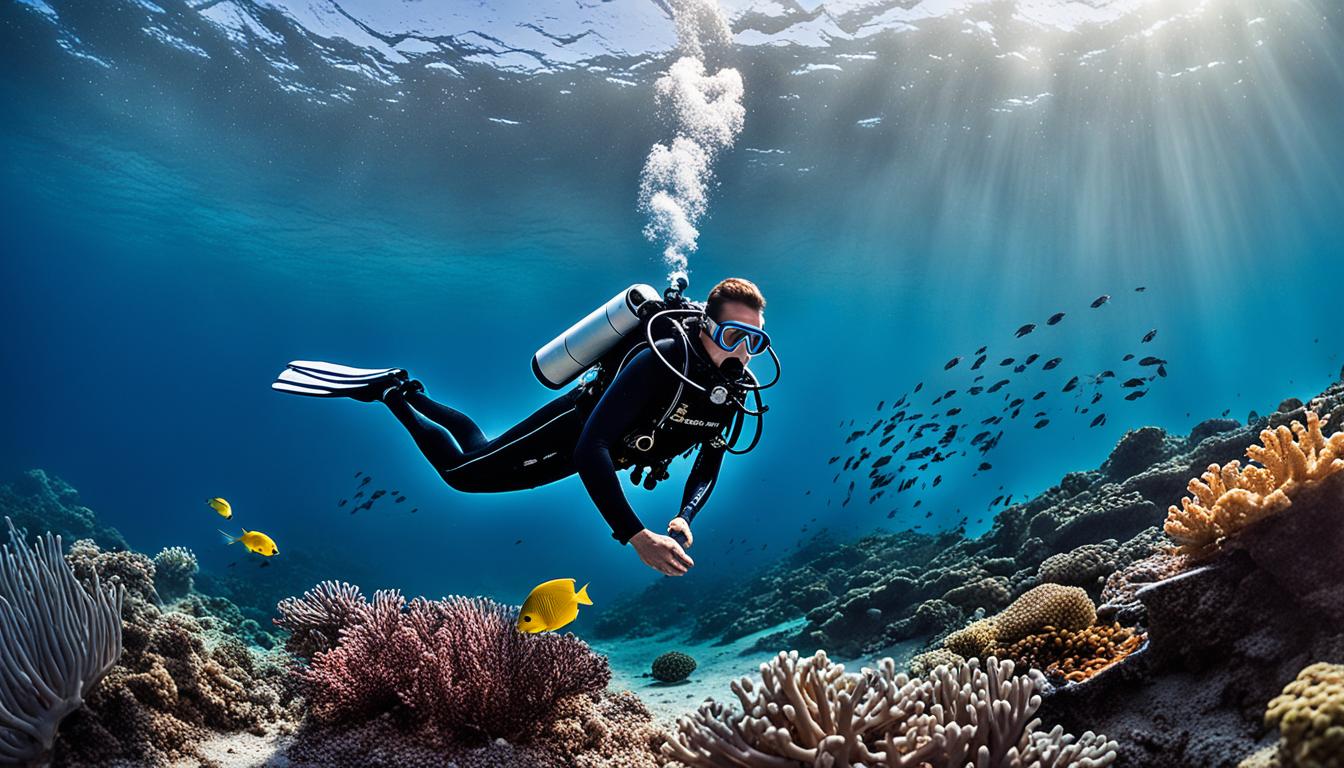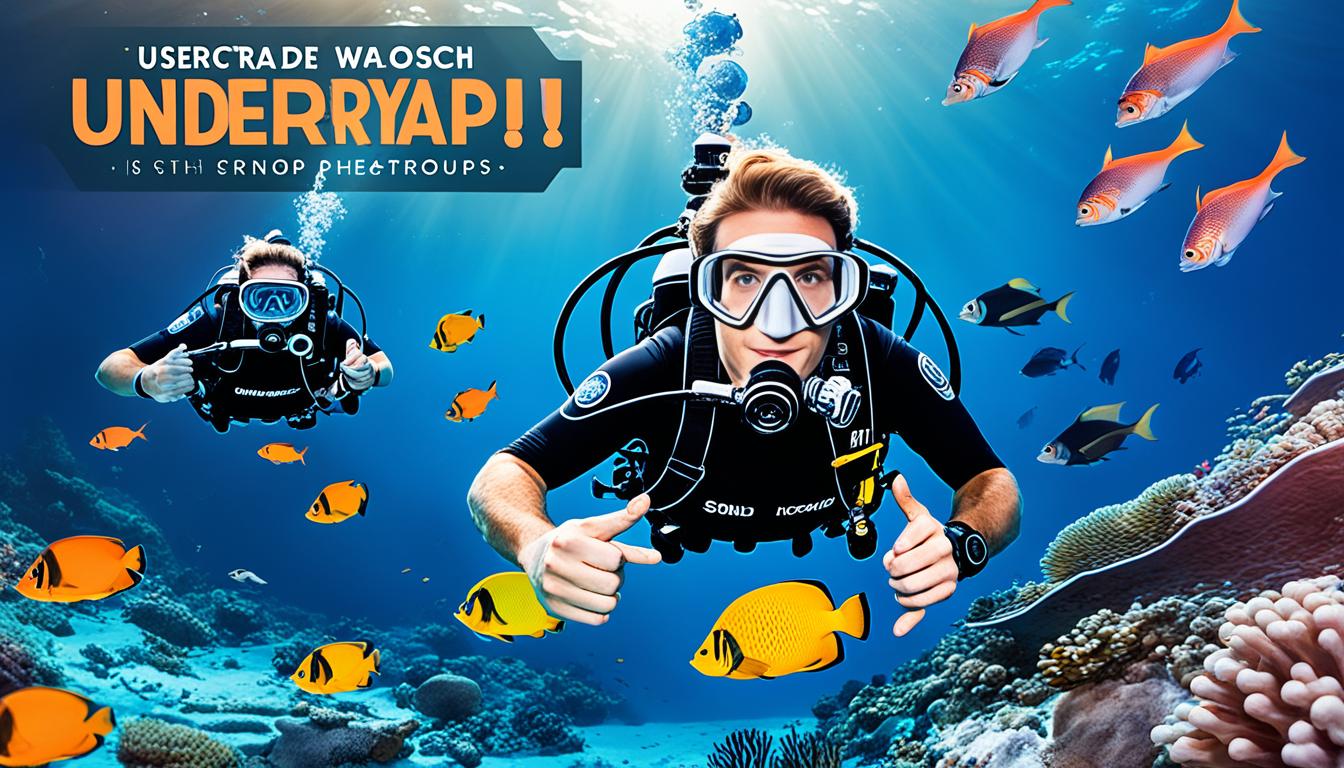Welcome to our guide on underwater videography basics and equipment. If you’re interested in capturing the stunning beauty of the underwater world, this is the perfect place to start. In this article, we’ll walk you through the essential gear you need to create captivating underwater videos that will leave a lasting impression.
Key Takeaways:
- Underwater videography requires the right equipment for optimal results.
- The camera is the most important piece of gear. Consider options such as GoPros, DSLRs, mirrorless cameras, compact cameras, or video cameras.
- Underwater camera housing is essential for using a non-waterproof camera underwater. Choose the housing that suits your camera model.
- To become a professional underwater videographer, you’ll need scuba diving gear and certification.
- Lighting plays a crucial role in underwater videography. Explore options like video lights and strobes to enhance your footage.
So, let’s dive in and discover the world of underwater videography together!
Choosing the Right Camera
The camera is the most important piece of gear for underwater videography. It’s crucial to choose a camera that suits your needs and preferences. Let’s explore some options:
GoPro
GoPro cameras are popular among underwater videographers for their compact size, versatility, and durability. They are designed to withstand harsh underwater conditions and capture stunning footage. GoPros are great for beginners and those looking for an all-in-one solution.
DSLRs
For those seeking higher quality video footage, DSLRs are an excellent choice. DSLRs offer superior image and video resolution, interchangeable lenses, and advanced features. They provide more control over manual settings and allow for customization to achieve professional-looking results.
Mirrorless Cameras
Mirrorless cameras are becoming increasingly popular among underwater videographers. They offer the portability of compact cameras combined with the image quality and versatility of DSLRs. With their smaller form factor and advanced features, mirrorless cameras are a great option for capturing high-quality underwater footage.
Compact Cameras
Compact cameras are a convenient choice for underwater videography due to their small size and ease of use. They are lightweight, portable, and usually waterproof or come with underwater housing. Compact cameras are suitable for beginners or those looking for a budget-friendly option.
Video Cameras
Video cameras specifically designed for underwater use are another option for capturing underwater footage. They offer specialized features for underwater videography and are often used by professionals. Video cameras provide excellent image stabilization and are capable of recording high-quality video.
When choosing an underwater camera, consider your budget, level of expertise, desired features, and the type of footage you want to capture. It’s important to research and compare different models to find the best underwater camera for your specific needs.
Underwater Camera Housing
When it comes to capturing breathtaking footage underwater, having the right equipment is essential. One crucial piece of gear that allows us to use non-waterproof cameras for filming underwater is underwater camera housing. This protective housing is designed to keep our cameras safe and dry while submerged in water, ensuring that we can capture stunning shots without any worry.
Underwater camera housing is available for various types of cameras, including video cameras, DSLRs, GoPros, and even cellphones. No matter what camera you use, there is likely a compatible housing available to suit your needs.
Using underwater camera housing offers more than just waterproof protection. It provides camera stability and control while filming underwater, allowing us to achieve steady footage and maintain the clarity of our shots. This stability is crucial, as water currents and movements can easily cause shaky footage without the use of proper housing.
To ensure high-quality footage, it’s important to invest in a reliable and sturdy underwater camera housing that fits your specific camera model. This will help us capture the beauty of marine life with precision and detail, creating a mesmerizing visual experience for viewers.
Underwater camera housing provides the necessary protection, stability, and control to capture professional-quality footage underwater. It allows us to use our preferred cameras, whether DSLRs or GoPros, and ensures that our footage remains stable and free from water damage. It’s an essential piece of gear for any underwater videographer.
In addition to underwater camera housing, other equipment such as waterproof cameras, scuba diving gear, underwater lighting equipment, monitors, and video editing software also play vital roles in underwater videography. In the next sections, we will explore these components in detail, helping you understand the essentials and gear required for successful underwater videography.
Scuba Diving Gear
As professional underwater videographers, we understand the importance of being a qualified scuba diver. Alongside your camera gear, having the right scuba diving equipment is essential for capturing stunning footage. Let’s take a look at the scuba diving gear you’ll need to enhance your scuba diving videography experience.
Oxygen Tank
The oxygen tank, sometimes referred to as a scuba tank or cylinder, is your source of breathable air underwater. It’s important to choose a tank that suits your diving needs and provides an adequate supply of air for your dives.
Breathing Regulator
The breathing regulator attaches to the oxygen tank and delivers air to you through the mouthpiece. It ensures a steady supply of air while diving, allowing you to focus on capturing amazing underwater footage.
Wetsuit
A wetsuit helps regulate your body temperature and provides protection underwater. It keeps you warm by trapping a thin layer of water between your skin and the suit, which then gets warmed by your body heat.
Fins
Scuba diving fins, also known as flippers, enhance your underwater mobility and help you move through the water efficiently. They provide propulsion, stability, and control, enabling you to position yourself for the perfect shot.
Mask and Snorkel
A good quality diving mask and snorkel are essential for clear vision and comfortable breathing underwater. The mask creates an air pocket around your eyes, allowing you to see clearly, while the snorkel enables you to breathe while at the surface without removing your mask.
BCD (Buoyancy Control Device)
The BCD is a crucial piece of gear that allows you to control your buoyancy underwater. It helps you achieve neutral buoyancy, ensuring you stay at the desired depth and maintain stability while recording your scuba diving adventures.
Depth Gauge or Dive Computer
A depth gauge or dive computer enables you to monitor your depth and bottom time during a dive. It provides important information for managing your dive profile, safety stops, and decompression limits.
Weight Belt
A weight belt is used to offset the buoyancy of your body and equipment. It helps you achieve neutral buoyancy by adding or removing weights as needed to maintain control and stability in the water.
Other Accessories
Additional scuba diving accessories, such as dive lights, dive knives, underwater write slates, and underwater photography accessories, can enhance your scuba diving videography experience. These tools help you overcome challenges and capture those underwater moments in the best possible way.

Now that we’ve covered the essential scuba diving gear, you’re one step closer to becoming a proficient underwater videographer. Don’t forget to obtain your scuba certification to ensure a safe and enjoyable diving experience. Let’s dive into the next section, where we’ll explore the importance of underwater lighting equipment.
Underwater Lighting Equipment
When it comes to underwater videography, lighting plays a crucial role in capturing stunning footage. As you descend deeper into the depths, the vibrant colors of the underwater world start to fade. To overcome this challenge, it’s essential to invest in the right underwater video lighting equipment.
Underwater lighting equipment includes a variety of tools such as video lights, strobes, and red filters for GoPros. These devices not only illuminate the subject but also restore the natural colors that are lost underwater. Whether you’re shooting in a shallow reef or exploring dark caves, having the right lighting equipment will dramatically enhance the quality of your videos.
For beginners, starting with one light is usually sufficient to achieve beautiful results. However, as you gain more experience and tackle different shooting scenarios, you may find it beneficial to use multiple lights for various purposes. This could include highlighting specific details, eliminating shadows, or creating dynamic lighting effects.
Adding light to your underwater footage not only enhances the visual appeal but also allows for better depth perception and detail visibility. It’s important to experiment with different angles, distances, and intensities of light to achieve the desired effect for each scene.
At a Glance: The Benefits of Underwater Lighting Equipment
| Benefits | Details |
|---|---|
| Restoring Colors | Underwater lights and filters bring back the vivid colors that are lost underwater, making your footage vibrant and lifelike. |
| Enhancing Details | Proper lighting allows for better visibility of textures, patterns, and fine details, making your footage more engaging. |
| Creating Depth Perception | Strategically placed lights help create depth in your shots, adding dimension and a sense of scale. |
| Eliminating Shadows | By illuminating shadowy areas, you can ensure that your subject is evenly lit, resulting in a more professional-looking video. |
| Flexibility and Versatility | With adjustable light angles, color temperatures, and intensity settings, underwater lighting equipment provides versatility for different shooting conditions. |
Investing in high-quality underwater video lighting equipment is essential for any aspiring underwater videographer. Whether you’re shooting documentaries, capturing marine life, or exploring shipwrecks, proper lighting will significantly enhance the overall quality of your footage.
Remember, the right lighting can make all the difference between a good video and an exceptional one. So, get your underwater lighting equipment ready and plunge into the depths to capture the true beauty of the underwater world!
Monitors
While not a compulsory piece of equipment, underwater video screens or monitors can be incredibly helpful for professional videographers. These devices are designed to assist videographers in focusing their cameras and getting a better view of what they’re filming in real-time.
Using an underwater video screen or monitor allows us to have a clear and precise visual representation of the footage as it is being captured. It helps us ensure that the composition, focus, and exposure are all on point, resulting in high-quality underwater videos.
Not only do these monitors provide a larger and more detailed viewfinder than the camera’s built-in screen, but they also allow us to assess the footage’s color and clarity with better accuracy. This is especially important when filming in challenging underwater conditions where visibility may be limited.
By using an underwater video screen or monitor, we can make on-the-spot adjustments to our camera settings and framing, saving us time and effort during the post-production process. It enables us to capture the perfect shot right away, reducing the need for extensive editing later on.
“Underwater video screens or monitors give us a real-time glimpse into what we’re capturing, allowing us to make immediate adjustments and ensure the best possible footage.” – Professional Underwater Videographer
Whether it’s a traditional monitor attached to the camera housing or a wearable underwater video screen strapped to our wrist, having this additional visual aid can greatly enhance our underwater videography experience and overall success.
| Benefits of Underwater Video Screens: |
|---|
| Real-time view of captured footage |
| Enhanced focus and composition |
| Improved accuracy for assessing color and clarity |
| On-the-spot adjustments to camera settings |
| Time and effort savings in post-production |
Underwater video screens or monitors can be valuable tools for professional videographers, providing us with a clearer and more detailed perspective of our underwater shots, resulting in visually stunning and captivating videos. While optional, they are certainly worth considering for those aiming to elevate their underwater videography skills.

Video Editing Software
Once you’ve captured your underwater footage, it’s time to bring your videos to life with video editing software. With the right tools, you can enhance your footage, add effects, and create a captivating final product. Let’s explore some popular options:
Adobe Premiere Pro
Adobe Premiere Pro is a professional-grade editing software widely used in the film and media industry. With its advanced features and intuitive interface, you can easily edit your underwater videos, apply effects, adjust colors, and add audio. However, it may have a steeper learning curve for beginners.
Final Cut Pro
Designed specifically for Apple users, Final Cut Pro offers powerful editing capabilities and a user-friendly interface. This software allows you to edit underwater videos seamlessly, enhance colors, add professional-grade effects, and work with multiple video formats.
Free Video Editors
If you’re on a budget or just starting out, there are free video editing programs available that can still produce impressive results. Here are a few options:
- iMovie: This pre-installed software on Mac computers offers a user-friendly interface with basic editing tools and effects.
- Windows Movie Maker: For Windows users, this software provides basic editing features, transitions, and audio options.
- Shotcut: A cross-platform, open-source video editor that supports a wide range of formats and offers advanced features such as 4K video editing.
- Filmora: With its easy-to-use interface, Filmora allows you to edit underwater videos, add effects, and create impressive visual storytelling.
- VideoPad: This intuitive software offers a user-friendly interface with basic editing tools, transitions, and audio options.
When choosing a video editing software, consider your specific needs, level of expertise, and desired features. Experiment with different software programs to find the one that suits your workflow and enhances your underwater videos.
Conclusion
Now that you have the essential underwater videography equipment, you’re ready to dive into your underwater filming hobby or kickstart your professional career. But don’t stop there! To truly master the art of underwater videography, consider enrolling in underwater videography courses. These courses will take your skills to the next level by teaching you advanced techniques, such as composition, lighting, and storytelling, specific to underwater environments.
In addition to honing your skills, investing in professional underwater video equipment can significantly enhance the quality of your footage. Brands like Sony, Canon, and GoPro offer a range of high-quality cameras and underwater camera housings designed specifically for underwater use. Paired with underwater video lighting equipment and video editing software like Adobe Premiere Pro or Final Cut Pro, you’ll be able to create stunning visuals that captivate your audience.
Whether you’re an aspiring underwater videographer or already have some experience, continuous learning and upgrading your equipment are key to staying ahead in this vibrant industry. So, take the plunge, explore the depths, and unleash your creativity through the lens of underwater videography. You never know where your underwater adventures might take you!
FAQ
What are the essentials for underwater videography?
The essentials for underwater videography include a camera, underwater camera housing, scuba diving gear, underwater lighting equipment, monitors, and video editing software.
What types of cameras are suitable for underwater videography?
Options for underwater cameras include GoPros, DSLRs, mirrorless cameras, compact cameras, and video cameras. GoPros are versatile, while DSLRs offer high-quality video footage.
Why is underwater camera housing necessary for filming underwater?
Underwater camera housing is necessary to use a camera that’s not waterproof for filming underwater. It provides camera stability and control, ensuring high-quality footage.
What scuba diving gear is essential for underwater videography?
Scuba diving gear includes an oxygen tank, breathing regulator, wetsuit, fins, mask, snorkel, BCD, depth gauge or dive computer, weight belt, and other accessories. Good buoyancy control is important for capturing steady footage.
Why is lighting important for underwater videography?
Colors get lost the deeper you go underwater, so lighting is crucial for capturing vibrant footage. Underwater lighting equipment includes red filters for
How can event photography gear be adapted for underwater videography?
When transitioning from event photography to underwater videography, essential event photography gear can be adapted to meet the demands of capturing footage beneath the surface. Utilizing waterproof housings for cameras and lenses, as well as underwater lighting equipment, can help ensure high-quality results when shooting underwater.




